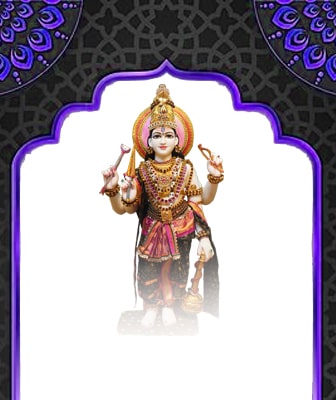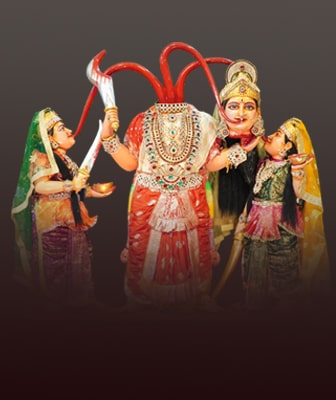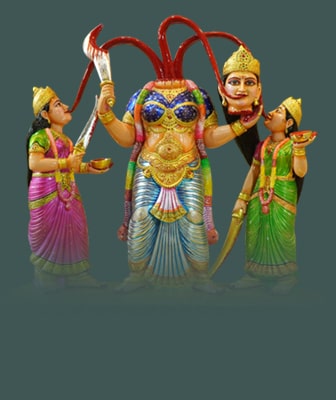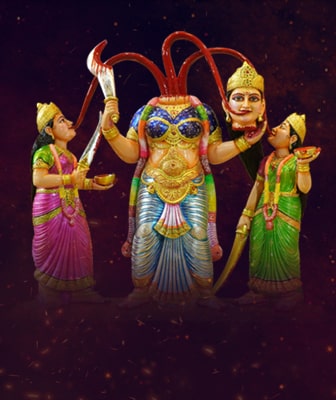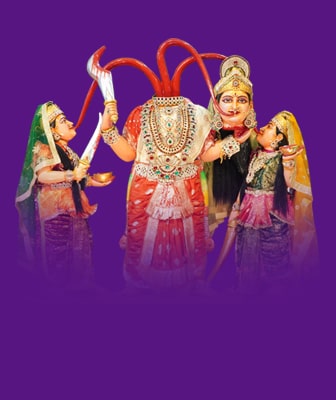Sri Chinnamasta Mahavidya
Chinnamasta is the fourth deity in the Dasamahavidya pantheon. Chinna means ‘chop’, and masta means ‘head.’ Chinnamasta means, a deity with a severed head. She hacked off her own head and held it in her hand, alluding to Khanda Yoga. As a result, it is apparent that she practices Khanda Yoga. Chinnamasta Mahadevi is a Hindu goddess who is often associated with the fierce aspect of Shakti, the divine feminine energy.
According to Tantric shastra and Ganapati Muni, Chinnamasta dwells in the Agna Chakra. She remains in Sushumna nadi, one of the three basic nadis (Ida Pingala and Sushumna). During meditation, they all eventually meet in the agnya chakra. When our breath flows through the sushumna nadi. It is the Nirvikalpa Samadhi state. In other words, samadhi is attained when the seeker traverses Brahma granthi, Vishnu granthi, and Rudra granthi..
Chinnamasta Devi worship is observed on Tuesdays or in the evenings during sunset (Sandhya Samayam). People born during the time of Ashwini, Moola, or Makha stars should worship this goddess. Seekers who are committed to awakening their Kundalini shakthi should worship her.
Chinnamasta's true name is Prachanda Chandi, the form of Adiparashakthi and one among the Nava Chandis. Her other names are Indrani, Vajravairochani, and Chanda Prachandi Devi. Her Ashta Shakthis (eight powers), are Dhakini, Varnini, Eka Linga, Maha Bhairavi, Bhairavi, Indrani, Ashtangi, and Samharini.
She provides you with health and enables you to experience life beyond your body. If you adore her, choose one of the following three wishes for her: extreme financial happiness, eternal bliss, or the annihilation of your foes (Mara). She takes off all your bondages. In addition, worship her if you want to get rid of lust. Lord Buddha adored her and vanquished it.
According to the Vedas, the supreme deity is Indra (one of Shiva's names), and his shakthi (queen) is Indrani, the rishika and the presiding deity for 29 mantras in the Rigveda and four mantras in the Atharvaveda. This Indrani is Chinnamasta devi.
Chinnamasta Devi and Ganapati Muni- An intuitive connection
Bhagavan Ramana Maharshi's beloved disciple Kavyakantamahaganapati (popular as Ganapati Muni) discovered the secrets of Chinnamasta Devi. On Ramana Maharshi's path, he was unable to identify his true self. He obtained Mantra Siddhi by chanting the Tara Devi Beejakshara mantra. Feeling contented, Taradevi manifested to him and advised him to worship Chinnamsta Devi. Following her directive, he began to worship Chinnamasta Devi.
While he continued his worship, one day when he was in Chuta Guha with his wife, Visalakshi, he had an excruciating headache. His Sahasrara chakra broke (opened), and smoke began to emanate from his head. This report reached Ramana Maharshi, who arrived there immediately. Feeling complaced, Ramana Maharshi gave two kinds of oil to Mahaganapati and directed him to apply it then the smoke dissipated in the morning.
By worshipping Chinamasta devi, he obtained Suvarna Siddhi, (meaning the ability to turn metal into gold). He revealed Ramana Maharshi's previous birth, achieved omnipotence, and revealed Chinnamasta's true name is Prachanda Chandi, the form of Adiparashakthi and one among the Nava Chandis.
Sankalpam
Stipulations for chanting Sri Chinnamasta Mahavidya Beejakshara Mantra
- To receive complete blessing of Dasa Mahavidya, the seeker should themselves become a disciple of a self-realized guru (or a Siddhaguru).
- If your Guru is self-realized, seek permission from your guru to learn Sri Chinnamasta Mahavidya from Siddhaguru Sri Ramanananda Maharshi.
Else chant:yetat kshanameva aham Siddhaguru Sri Ramanananda Maharshi na ha sishya ha bhavami.
(At this moment itself, I wholeheartedly accept “Siddhaguru Sri Ramanananda Maharshi” as my guru. - Promise him that you never trouble him, submit to him with utmost devotion on him and eventually endeavor to become enlightened.
- Light three Agarbattis at your pooja mandir.
- One who performed the death rituals should not chant this mantra for 3 months and his family for 11 days.
- Women are not permitted to chant this mantra during menstruation.
- These mantras can be chanted aloud(if you are alone) or softly under breath.
- Communicating mantras to anyone is strictly prohibited.
Beejakshara Mantram
HOOM
हूं
Chinnamasta Mahadevi's beejakshara mantram is 'Hoom'. This mantram is the combination of Shiva and Shakti Beeja. The primary benefit of reciting this mantra is that it will eliminate your foes or those try to who deceive you. 'HOOM' is the summation of 'Hakaram' and 'Oomkaram'. 'Hakaram' signifies shakthi beeja mantram which gives eternal wisdom, 'oom' is Shiva beeja mantram which gives spiritual strength. Chanting this beejakshara mantram aloud will transform your house into a temple. The benefits of repeating this mantra include eternal wisdom, enemy destruction, and Shiva's grace.
Moola Mantram
Seekers born during the time of Ashwini, Moola, or Makha stars should worship this goddess. Seekers who are committed to awakening their Kundalini shakthi should worship her. Tuesdays and evenings are the holy times to worship her.
Om Shreem Hreem Aim
Vajravairochaniye
Hoom Hoom Phat Swaha
ॐ श्रीं ह्रीं ऐं
वज्रवैरोचनीये
हूं हूं फट् स्वाहा


